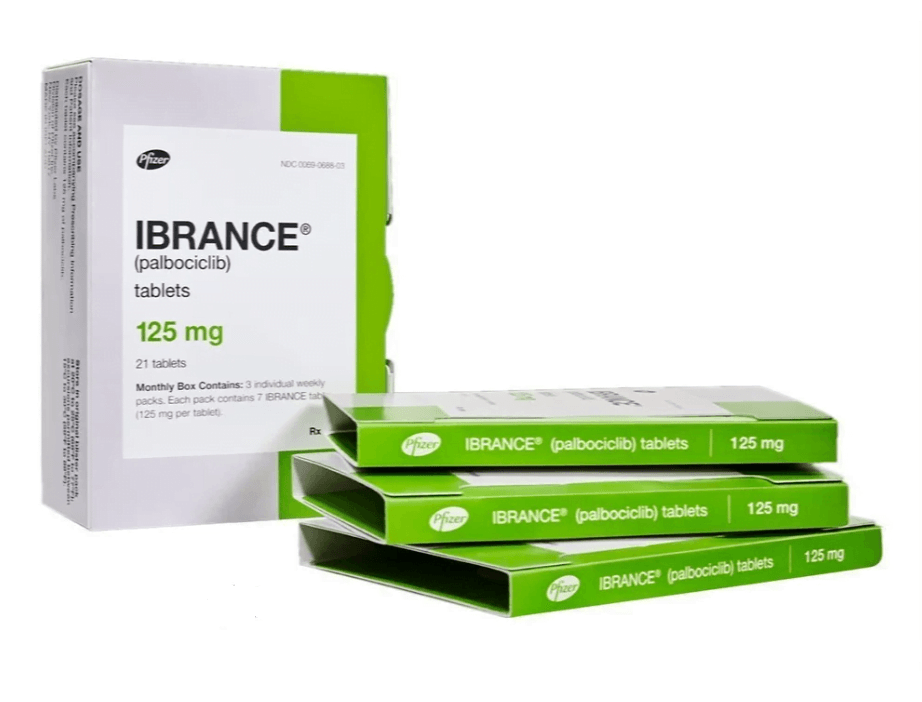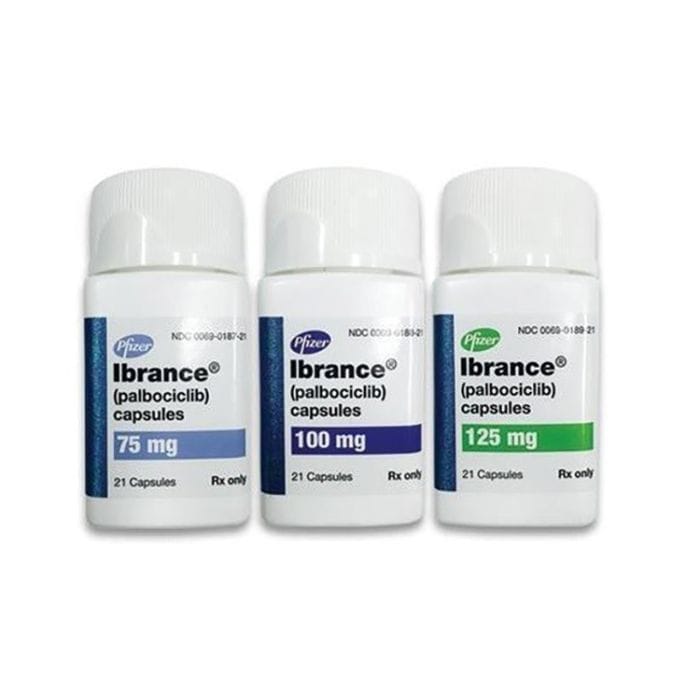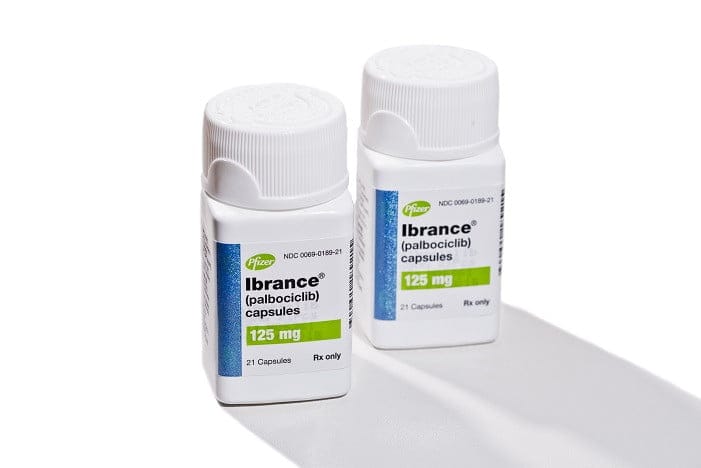Shipping with this method takes 3-5 days
Ibrance® Capsules for HR-Positive, HER2-Negative Breast Cancer
Stock up and Save - Get 20% off when you buy 3 or more of any one product. Use code SAVE20 at checkout.
Coupon code cannot be combined with other offers. Sale applies to all products originating from Canada. Maximum allowable quantity equal to a 90 day supply per single order.
$7,350.99
Secure Encrypted Payments
Ibrance® is an oral therapy used for certain advanced breast cancers. This page explains how it works, who it may suit, and how to arrange US shipping from Canada. You can also review access basics, prescription needs, and ways to estimate costs without insurance.
What Ibrance Is and How It Works
This medicine contains palbociclib, a cyclin-dependent kinase 4/6 (CDK4/6) inhibitor. It helps slow the growth of hormone receptor–positive, HER2-negative breast cancer when used with endocrine therapy. Clinicians often pair it with an aromatase inhibitor such as Exemestane or with Fulvestrant. It may also be appropriate for men, usually with additional hormonal suppression as guided by the prescriber.
YouDrugstore is a licensed Canadian pharmacy in Manitoba. Pharmacists review prescriptions before dispensing.
Palbociclib works by blocking enzymes that drive cell division in some breast cancers. By inhibiting CDK4 and CDK6, it can delay progression when combined with hormonal treatment. Learn more about the condition through our categories HER2 Negative Breast Cancer and Hormone Receptor Positive, and see related reading on Breast Cancer Management.
Who It’s For
This treatment is indicated for adults with hormone receptor–positive, HER2‑negative advanced or metastatic breast cancer. It is used:
- First-line setting with an aromatase inhibitor
- After prior endocrine therapy with fulvestrant
- In eligible men under specialist guidance
People who are pregnant or may become pregnant should not use this medicine. Effective contraception is recommended during therapy and for a period after the last dose according to the official label. Those with severe allergies to any component should avoid it. Discuss your medical history, including liver problems or current infections, with your healthcare professional.
Dosage and Usage
The usual schedule is once daily for 21 days, then 7 days off, repeating in 28‑day cycles. Capsules are taken with food at the same time each day. Swallow capsules whole; do not open, crush, or chew. Your prescriber will choose a starting dose and may adjust based on blood counts and tolerability. Always follow the official label and your provider’s directions.
It is commonly used with an aromatase inhibitor such as Anastrozole or with fulvestrant. Avoid grapefruit or grapefruit juice, which can affect medicine levels. If you have questions about timing with other therapies, ask your clinician or pharmacist.
Strengths and Forms
Palbociclib is supplied as oral capsules in commonly published strengths of 75 mg, 100 mg, and 125 mg. Packaging and availability may vary by country and manufacturer.
Missed Dose and Timing
If you miss a dose or vomit after taking one, do not take an extra capsule. Take the next dose at the usual time the following day. Try to take doses consistently each cycle. If you miss multiple doses, contact your prescriber for guidance.
Storage and Travel Basics
Keep capsules in the original container with the lid closed. Store at room conditions away from excess moisture and direct light. Keep out of reach of children and pets. Do not transfer capsules to a pill organizer unless your pharmacist confirms it is appropriate.
When traveling, pack your medication in your carry‑on with a copy of your prescription. Keep a simple dosing plan that accounts for time zone changes. Do not leave medicine in hot cars or near heaters. If you need help planning travel around treatment cycles, ask your healthcare team for written instructions.
Benefits
In combination with endocrine therapy, this class can help delay disease progression in eligible patients. It is taken by mouth, which may fit routine daily schedules. The 28‑day cycle structure provides clear on‑ and off‑treatment periods. Many patients appreciate coordinated monitoring, as blood tests help guide safe, individualized use.
Side Effects and Safety
- Low white blood cells (neutropenia)
- Infections or fever
- Fatigue and weakness
- Nausea or decreased appetite
- Stomatitis or mouth sores
- Diarrhea or constipation
- Hair thinning
Serious risks can include severe neutropenia, febrile neutropenia, or lung inflammation. Your prescriber may monitor complete blood counts, especially early in treatment cycles. Report signs of infection, shortness of breath, or unusual bleeding promptly. Use effective contraception and avoid pregnancy during therapy. Breastfeeding is not recommended during treatment and for a period after, as directed by the label.
Drug Interactions and Cautions
Strong CYP3A inhibitors (for example, clarithromycin, itraconazole) can raise palbociclib levels. Strong CYP3A inducers (for example, rifampin, carbamazepine) can lower levels. Avoid grapefruit products. Tell your healthcare professional about all medicines, supplements, and herbal products you take. Your prescriber may choose alternatives that minimize interaction risk. Alcohol use should be discussed with your care team.
What to Expect Over Time
Your care plan typically includes lab testing before starting and at the beginning of cycles. Blood counts may be checked more often at first, then less frequently once stable. Some people need dose adjustments based on tolerability. Taking capsules at the same time each day may help with routine and adherence.
Many patients and caregivers also plan for financial aspects. Discuss support resources and coverage options early. If needed, your pharmacist can explain the process to estimate the Ibrance price without insurance using your prescription details and quantity.
Compare With Alternatives
Other CDK4/6 inhibitors are available. Verzenio (abemaciclib) is taken orally and may be dosed continuously without an off week. Kisqali (ribociclib) is also given in cycles and often paired with endocrine therapy. Choice among these options depends on your history, combination partner, monitoring needs, and tolerability.
Ask your prescriber which option aligns with your treatment goals and monitoring plan. For budgeting discussions, your pharmacist can explain how to review Palbociclib capsules price alongside similar therapies.
Pricing and Access
We offer Canadian pricing with flexible access steps for US patients. You can review Ibrance price when you sign in and provide a valid prescription. For comparisons or alternatives, pharmacists can also discuss Palbociclib price based on strength, quantity, and cycle length. We support encrypted checkout for your security.
To reinforce convenience, orders Ships from Canada to US after your prescription is processed by our team. For periodic deals, see our Promotions. If you are evaluating Ibrance Canadian pricing, our team can help you interpret options shown on the product page.
Availability and Substitutions
Stock and packaging can vary by country and manufacturer lot. If your item is temporarily unavailable, your prescriber may recommend a suitable alternative in the same class or adjust your endocrine partner. For estimates tied to location and cycle planning, our team can provide context about Palbociclib price from Canada when you share your prescription details.
Patient Suitability and Cost-Saving Tips
This therapy may suit adults with hormone receptor–positive, HER2‑negative advanced disease when used with endocrine therapy. It may not be appropriate if you are pregnant or have severe hypersensitivity to any component. Your prescriber will consider blood counts, liver function, and prior endocrine therapy when choosing a regimen.
- Multi‑month fills: fewer refills and steadier access
- Refill reminders: stay on track with cycles
- Combination planning: align endocrine partner supply
- Insurance review: coordinate benefits and copays
- Financial counseling: request a pharmacy invoice summary
For budgeting, ask your care team for a monthly estimate. They can help you understand Ibrance cost per month in the context of your dosing plan and combination therapy.
Questions to Ask Your Clinician
- Cycle schedule: how monitoring fits your routine
- Side effects: what to watch and when to call
- Interactions: medicines, supplements, and grapefruit
- Combination choice: which endocrine partner suits you
- Travel timing: doses across time zones
- Affordability: Palbociclib cash price options
Authoritative Sources
Pfizer Product InformationFDA Prescribing InformationHealth Canada Drug Product Database
Pricing and Access Resources
For education on endocrine partners, see our article on Postmenopausal Breast Cancer, and browse our Cancer category for related therapies.
Ready to get started? Add your prescription details and proceed to checkout for prompt, express, temperature-controlled handling when required, and US delivery from Canada. This page is informational and does not replace advice from your healthcare professional.
Express Shipping - from $25.00
Prices:
- Dry-Packed Products $25.00
- Cold-Packed Products $35.00
Shipping Countries:
- United States (all contiguous states**)
- Worldwide (excludes some countries***)
Standard Shipping - $15.00
Shipping with this method takes 5-10 days
Prices:
- Dry-Packed Products $15.00
- Not available for Cold-Packed products
Shipping Countries:
- United States (all contiguous states**)
- Worldwide (excludes some countries***)


